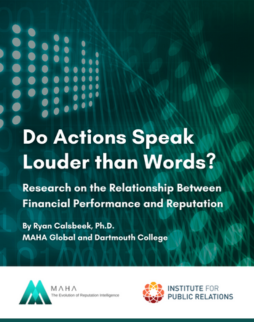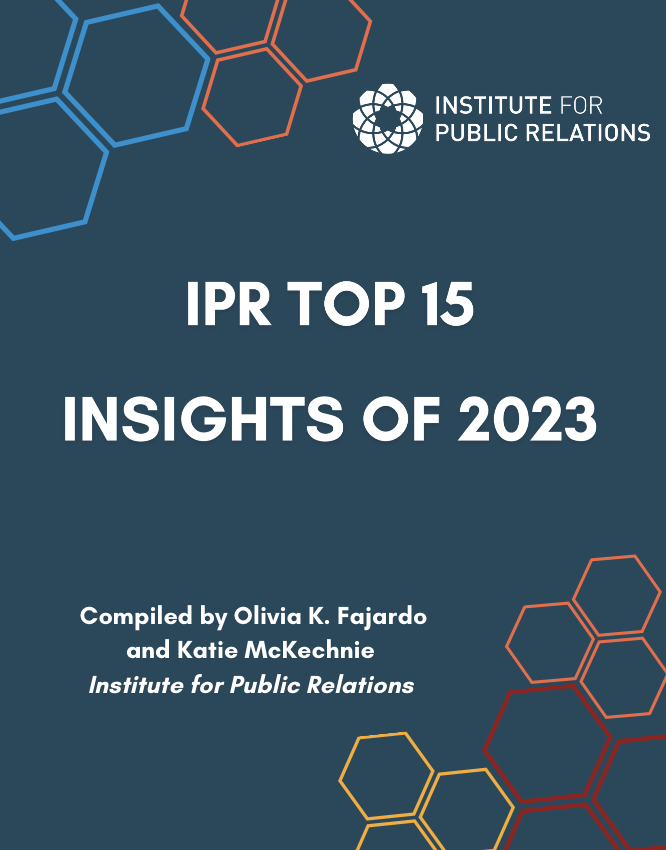Cayce Myers, Ph.D., J.D., LL.M., Legal Research Editor for Institute for Public Relations, Assistant Professor in the Department of Communication at Virginia Tech | mcmyers@vt.edu
Download Full Paper (PDF): Protecting Online Image in a Digital Age: How Trademark Issues Affect PR Practice
Executive Summary
Trademark law directly affects the level of control a public relations practitioner can have over a client’s image. Although U.S. trademark law has retained its core tenets since 1946 (the year the Lanham Trademark Act was passed), social media platforms have presented new challenges for regulating, protecting and controlling the (mis)use of trademark property. Social media presents two distinct challenges to image management. First, social media and the internet are a forum in which infringement is easy to commit and difficult to catch. Second, infringement, especially in the form of parody accounts, can have a lasting impact on public opinion. Because of this, practitioners need to know how their work affects the strength of trademarks, and how their use of trademarks impacts infringement lawsuits.
Trademark is one of the most powerful forms of intellectual property because it protects an organization’s image (e.g. logo, trade name, packaging, color scheme) and can potentially last forever. Public relations plays an important role both in the creation and maintenance of trademark. This is partially because a trademark’s strength is directly related to its use. Communication strategies constitute a trademark’s use, and the greater the amount of use the more powerful a trademark can become. In fact, non-use of a trademark can signal that a trademark has been abandoned and is therefore in public domain (meaning anyone is free to use the mark). This presents a challenge for public relations practitioners who may represent a client who has an old image that they still want to control. Public relations practitioners should note that use of a trademark means actual use under the law. Merely holding on to a trademark for royalties or challenging infringers does not necessarily mean use.
Another area that public relations communications can affect trademark is genericity. Generic names do not receive trademark protection under U.S. law. However, genericity is a process by which protected trademarks lose their legal protection. This happens when overuse of the trademark causes the trademark to cease having specific meaning to a particular brand. For instance, aspirin, cellophane, thermos, escalator and zipper are all trademarked names that became genericized. When a trademarked name becomes synonymous with a general product and not a specific brand, the trademark potentially can end. Public relations practitioners can avoid this genericide by carefully scanning external uses of trademarks, particularly media use. Additionally, public relations practitioners should take care to only use trademark names in particular contexts that relate only to their clients.
Strengthening a trademark by careful management and avoiding the pitfalls of genericity are two areas of trademark law that a practitioner can proactively manage through their own communications. However, infringement, or the unauthorized use of trademarks, and dilution, unauthorized trademark use that causes reputational damage to the trademark, is something that sometimes requires lawsuits to force infringers to stop. This is not as easy as it may seem, and, given the increased amount of infringement, online detecting and reducing infringement can be a difficult task.
One form of trademark infringement is cybersquatting, or the illegal use of a trademark name on a website’s domain name. This is accomplished by using a trademark name as a domain name, or by using a misspelling of a trademarked name on an IP address. Frequently cybersquatting is difficult to detect because domain name registration may be done under false names or by third parties that are part of larger cybersquatting schemes. The purpose behind cybersquatting is to siphon off users from legitimate websites and taking them to these unauthorized accounts. Sometimes these accounts redirect users to different websites, provide links to merchandise from competitors, and even sell third parties advertising space. This type of trademark infringement is potentially very costly to the actual owner of the mark. It affects online reputation because it gives the appearance of a legitimate site, and it also attempts to take business from the rightful trademark owner. Domain name registrars frequently have a difficult time locating the identities of the infringing parties, and registrars in some jurisdictions (such as the Ninth Circuit) are immune from liability (Academy of Motion Pictures Arts and Sciences v. GoDaddy.com, Inc., 2015).
The second issue arising from online trademark infringement is parody accounts. These accounts can erode the online image of an organization, especially when they have a large following. Although parody accounts often hold themselves out to not be “real” person or organization, their criticism of their subjects can be detrimental. However, it is important for public relations practitioners to note that different laws govern parody accounts for organizations and individuals.
In the past, organizations had great ability to suppress parody, and frequently parody lawsuits favored the trademark owner. However, after the U.S. Supreme Court’s decision in Campbell v. Acuff-Rose (1994) there is an increasing number of parody lawsuits in which the trademark owner lost. This has even been true in cases where the parody was highly critical of the trademark, and even in cases where the parody make money from the use of the trademark (Louis Vuitton Malletier v. My Other Bag, Inc., 2016; Radiance Foundation Inc. v. NAACP, 2015).
Parody of individuals presents a different issue because parody, especially of well-known people, has protection under the First Amendment. If a person is a public official, public figure, or limited purpose public figure, a lawsuit for emotional distress caused from a parody requires the plaintiff to show actual malice, a very high legal standard (Hustler Magazine v. Falwell, 1988). Parodies of private individuals do not require this rigorous standard, and typically private individuals have an easier time bringing a lawsuit over a parody account. Because well-known individuals have a more difficult time successfully suing over parodies, some public relations practitioners have used various communication strategies to combat negative portrayals found in parody accounts. One of the most popular strategies is engagement with the parody account. This can both diminish the negative impact of the account as well as bring attention to the “real” account.
All of the trends in trademark law show that public relations practitioners are essential to the protection of this form of intellectual property. Given the complexities of online image management it is important for public relations practitioners to know that their strategies directly influence both the strength and durability of a trademark. Because courts have become more receptive to parodies practitioners now more than ever can use their communication strategies to create solutions to legal issues.
Download Full Paper (PDF): Protecting Online Image in a Digital Age: How Trademark Issues Affect PR Practice



